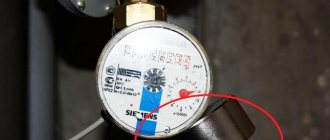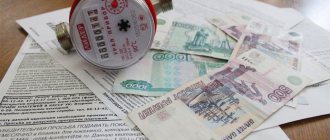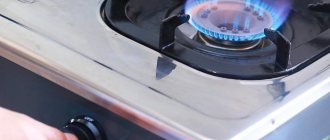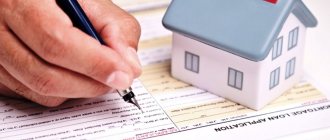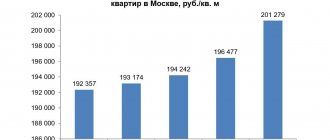In residential premises, if technically possible, special devices must be installed that take into account the consumption of water and energy resources. In addition to individual meters directly in apartments, it is necessary to install communal meters. This measure encourages residents to save on expensive services. There are standards and regional tariffs for utilities. In the case where homeowners have not installed metering devices, a multiplying factor (abbreviated as PC) is applied to the calculation of consumption.
What is a multiplying factor and its use in the absence of metering devices
The increasing factor is a certain numerical value by which the tariff for the provided utility service will be multiplied in the event of non-compliance with the requirements of the regulatory act, namely the absence of a meter.
The value of the coefficient is established by law and serves as a penalty for those who violate the implementation of acts on the mandatory installation of metering devices.
Is it possible to avoid tariff increases without installing meters?
It is possible if the use of devices is impossible for the following reasons:
- housing is recognized as unsafe or dilapidated;
- installation requires network repair;
- pipes or wiring are faulty;
- if the environmental conditions are not suitable for operating the meter (humidity, temperature, electromagnetic radiation).
Metering devices are applied to public services:
- hot water supply;
- cold water supply;
- heat supply;
- electricity.
Meters record the actual consumption of the above categories; payment for utilities is made on the basis of this data.
Until recently, installing meters was not very profitable, because in fact, more people could live in the apartment, and the fee was charged to those registered at the average rate. Since 2014, based on new regulations, the authorities began to apply increasing coefficients if residents do not provide accurate data.
It is important to know! The application of the increasing coefficient is possible only to property owners. In other cases, the municipality or landlord is responsible.
The coefficient comes into effect:
- if devices for recording the consumption of cold water, hot water, heating, electricity are not installed;
- if 3 months have passed since the device broke down, it has not been repaired or replaced;
- or if the owner does not confirm the accuracy of the information and does not allow a housing and communal services specialist to inspect it.
Important! The coefficient has been calculated since 2020 and is steadily growing. So, in 2020 it was 1.1, and from January 1, 2020, 1.6. However, it was later adjusted to 1.5. This means that today the additional payment at the current tariff is 50% . However, there are no plans to raise the coefficient in 2020. In the payment document, the RSO coefficient must be indicated in a separate line, and the basic standard must be indicated next to it.
How is water billed without a meter?
In the absence of a water meter for cold and hot water supply, the calculation is carried out according to the standard calculated in accordance with the methodological instructions developed by special commissions under the Government of the Russian Federation.
The water consumption standard is multiplied by the number of citizens registered in the apartment and the tariff in force in the given region. Next, this figure increases by an increasing factor, that is, by 50% or 1.5 times.
There are exceptions to the application of the multiplying factor. They consist in the fact that the apartment does not have the technical ability to install a water meter or the housing is considered unsafe. The fact that the installation is impossible or the housing is in disrepair must be recorded in an act drawn up by a special commission at the initiative of the resident. Only in confirmed cases, the mandatory surcharge for the public water supply service is not applied.
In case of any malfunctions that are not eliminated within three months from the date of their discovery by representatives of the water utility or management company on the water supply system, an increasing factor will be added to the standard payment for water.
The introduction of a surcharge is economically justified; the careless attitude of consumers towards natural resources determines the adoption of such measures, and each person can decide for himself whether to save water by monitoring its consumption using metering devices or accept payment increases as a matter of course.
Increasing coefficient for heating
In addition to intra-apartment measuring devices, the management company is obliged to install general devices that measure heat consumption in apartment buildings. If there is metering equipment, residents pay for heat energy not according to the standard, but according to the fact of consumption.
At the end of February 2020, the heating PC was reduced from size 1.5 to 1.1. This is due to the procedure for using funds, which the utility company now has the right to dispose of independently. In 2020, the coefficient remains at 1.1.
The coefficient applies only to apartment owners and legal entities in case of residence or use of the premises for social needs.
Despite the fact that the decree came into effect only in March, resource supply companies (RSCs) are required to recalculate starting from January 2018 to everyone to whom PC was accrued.
Learn more about how heating charges are calculated. ⇐
The device cannot be installed
Despite the fact that the water utility recommends that everyone install a meter, not every apartment owner has the right to install a meter. You do not have the right to install the unit in the following cases:
- If the building in which your home is located is officially recognized as dilapidated or in disrepair.
- If, to install the device, the water utility must carry out major repairs of networks or the house.
- The device must not be installed without complying with accepted standards.
- The owner does not have the right to install the unit on water pipes in poor condition.
- Also, the device must be removed or not installed at all if it is to be operated in unsuitable conditions, that is, temperature, humidity or electromagnetic waves may interfere with the operation of the equipment.
If the homeowner knows that he does not have the right to install metering equipment for technical reasons, but receives payments that use an increasing factor, then he must do the following:
- Call an employee of the management company who will inspect the installation site of the device, assess the condition of the pipeline, and inspect the installation room.
- The employee must draw up a report. This document must clearly indicate why you cannot install metering equipment. In this case, the paper must indicate the house number, apartment and street.
- If you already have a device and its operating conditions have become improper, then you can ask workers to remove the unit until the conditions meet the requirements.
Conclusions: no one has the right to force you to install a meter, that is, forced installation is illegal.
Increased coefficient for water
In the absence of water consumption meters, if it is technically possible to install them, supply companies have the right to charge an increasing factor.
Household water consumption is paid according to consumption standards.
PC does not apply to wastewater disposal from June 2016 to the current year 2020, according to Decree of the Government of the Russian Federation No. 603. Thus, additional charges may only apply to water, hot and cold.
You can understand on your own how you pay for water with an increasing coefficient. Unfortunately, sometimes the average person has to double-check the correctness of the management company’s calculations.
⇒ Water tariff without a meter - useful information in the next article.
HVS
The water supply fee is calculated as follows: the number of registered residents is multiplied by the cold water consumption standard, PC (1.5) and the regional tariff. This calculation method is relevant for cold water.
DHW
How to calculate payment for hot water depends on the method used by the management company or RSO to tariff hot water consumption - in cubic meters or according to a two-component tariff - for cold water and thermal energy. In the first case, the calculation is made in the same way as for cold water. Tariffs that apply to two components of hot water supply require a calculation using a different formula: the volume of water according to the consumption rate is multiplied by the cold water component, the volume of heat required to maintain the temperature of hot water. All this is multiplied on the PC.
Thus, when calculating, it becomes obvious that the lack of individual water meters leads to a significant increase in the cost of utility bills!
How the multiplying factor is applied
The multiplying factor is used in several situations:
- If the apartment does not have water/electricity meters;
- The validity period of previously installed meters has expired. After the end of this period, 3 months are given to replace meters;
- There is no way to check the meters for the accuracy of the data transmitted to the structure of the management company, service provider and HOA.
In all, without exception, receipts for payment of housing and communal services that are received by apartment owners, increasing coefficients are written on a separate line. The home owner can always see how much he overpays on receipts, not wanting to install meters at home.
Water tariff without meters in 2020
This is not the case in civilized countries; water meters are installed everywhere. Where does the indicator of water consumption per person come from? The average rate of water consumption per person has been derived: The standard for water for those who have not installed meters in 2020 will increase 3 times. In the first half of the year, a coefficient of 3 will be added to the standard for consumption, from July 2020 - a coefficient 5.
Payment for water without a meter in 2020 in Moscow
Our house consists of 160 sq. m., we have not installed meters for more than 35 sq. m. The house is inhabited by northerners. Hence the question: why should bona fide owners pay, in addition to their own services, for services provided to others? The authorities are simply looking for ways to withdraw money in a simpler way, and let the residents fight among themselves. Hence the weakness of the government.
In all these cases, a recalculation can be achieved. It is carried out according to the scheme of minus 0.15% of the tariff rate for each hour without water in excess of the established standards, valid for both planned and emergency shutdowns. However, for recalculation it is necessary to submit an application to the management company.
A common mistake is to enter data on cold water supply consumption in the hot water column on the bill. In order not to confuse the pipes, it is important to remember that the riser (and, therefore, the meter) with hot pressure is located higher, and it itself will be warmer than the cold water connections.
Do I have to pay for hot water during the shutdown period?
- residents will not be notified of the shutdown at least 10 days before the start of work;
- the overlap period will exceed 14 days;
- the company will violate the hot water shutdown schedule;
- emergency shutdown hours will be over 4 hours per day or 8 hours per month.
As a result, it is much more profitable to pay only for the amount that was actually consumed, without overpaying for extra cubic meters of water. And this can only be done if you have an individual meter.
This is interesting: Criteria for a low-income family in 2020 in Moscow
Standard consumption of cold and hot water per person per month without a meter
This is a fairly large amount, which is difficult to cover without even saving water. But utility services have the right to increase it if necessary to cover their costs. At the same time, the upper limit is strictly limited - it should not be more than two standard sizes.
Cold water consumption per person without a meter
Citizens are required by law to install individual water meters in their apartments and houses. Of course, in the case where this can be done. If it is technically possible to install meters, but citizens refuse, then when calculating fees for using the resource, consumption standards with increasing coefficients are applied.
For reference! Experts do not expect a deterioration in payment discipline due to an increase in utility tariffs, because, according to them, this does not depend on the amount of payments. Today there is a situation in which even wealthy people are considered regular defaulters, while families with an average or minimum income pay their utility bills on time.
The latest official news about the growth of housing and communal services tariffs in Russia says that utility tariffs will be increased in two stages. As mentioned above, the average increase may be 3%, and more precise information on this matter will be known a little later. However, today we can say that this 3% will be divided into two parts. Tariffs will increase first in January and then in June. A similar practice was already in effect in 2020 by decree of Dmitry Medvedev.
We recommend reading: What should bailiffs do in a claim for non-payment of housing and communal services for non-residential premises
What can regular consumers expect?
To begin with, the percentage will be 5% of the amount declared for the reserve, but this situation will remain until January 1, 2020. In the future, the percentage will increase to 10 units, and then you will have to pay 15% for the reserve. In the future, the increase in housing and communal services tariffs for 2020 will not stop, because the percentage will further increase to 60 units in 2023.
Payment for current and major repairs of the house, intercom, security, and maintenance of common property is not included in utility costs. The government does not regulate such tariffs, so the actual rent may increase as early as January 1, 2020 and even more than the established regional indicators. The only ways to influence prices for these types of housing and communal services can be to change the management company or refuse certain services.
It will be up to local authorities to decide what the next increase in housing and communal services tariffs will be in different regions of the Russian Federation in 2020. The latter will be guided by the percentages established by Government Decree No. 2556-r dated October 29, 2020. The document presents the maximum indices for changes in payment for housing and communal services in general. At the same time, it is assumed that the cost of some resources (electricity, water, gas) may grow more strongly, while others – less. Theoretically, the total amount of citizens' expenses for utility bills should not increase by more than a given percentage for their region of residence.
When to Expect a Promotion
To reduce the burden on the family budget, certain categories of the population are also entitled to preferential conditions for paying for utilities. Moreover, citizens do not always realize that they have the right to receive them. At the federal level, benefits are provided to WWII participants, combat veterans, heroes of socialist labor, labor of the USSR, the Russian Federation, disabled people, Chernobyl victims, etc. Local authorities are expanding this list by including the least protected segments of the population: orphans, large families, veterans. In addition, regions provide subsidies for citizens whose utility costs exceed a certain share of income per family member (usually 10-20% depending on the region of residence).

